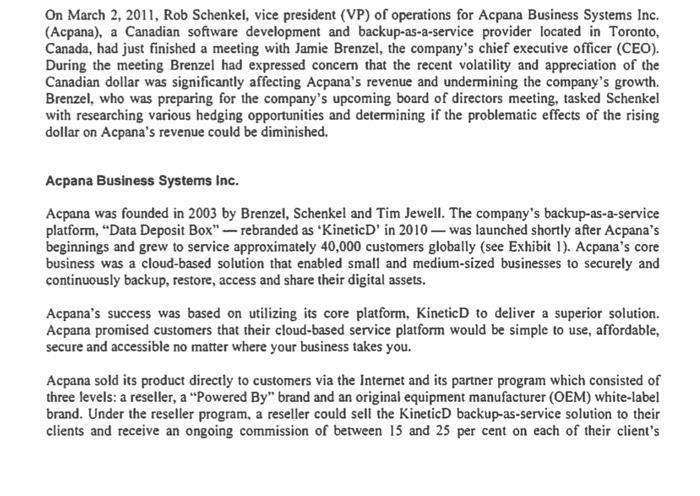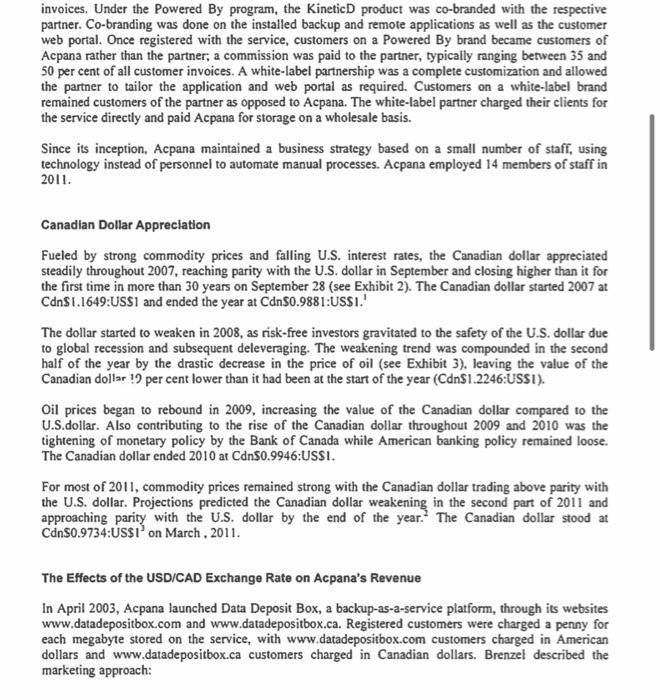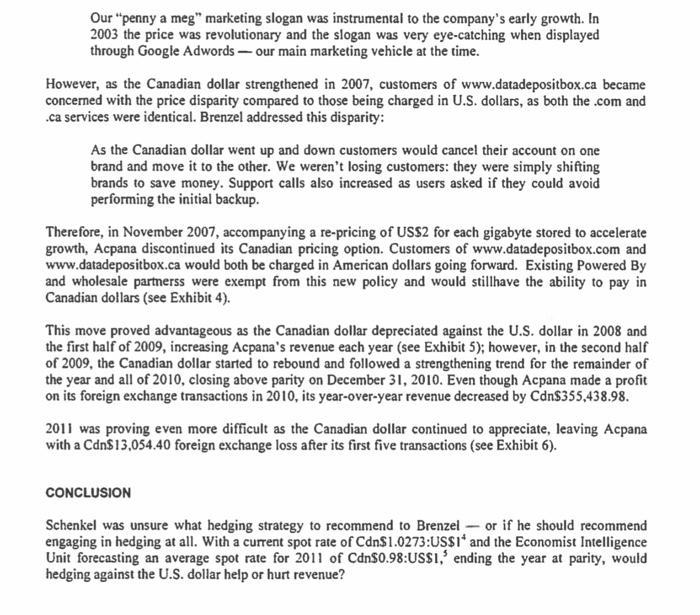Answered step by step
Verified Expert Solution
Question
1 Approved Answer
On March 2, 2011, Rob Schenkel, vice president (VP) of operations for Acpana Business Systems Inc. (Acpana), a Canadian software development and backup-as-a-service provider



On March 2, 2011, Rob Schenkel, vice president (VP) of operations for Acpana Business Systems Inc. (Acpana), a Canadian software development and backup-as-a-service provider located in Toronto, Canada, had just finished a meeting with Jamie Brenzel, the company's chief executive officer (CEO). During the meeting Brenzel had expressed concem that the recent volatility and appreciation of the Canadian dollar was significantly affecting Acpana's revenue and undermining the company's growth. Brenzel, who was preparing for the company's upcoming board of directors meeting, tasked Schenkel with researching various hedging opportunities and determining if the problematic effects of the rising dollar on Acpana's revenue could be diminished. Acpana Business Systems Inc. Acpana was founded in 2003 by Brenzel, Schenkel and Tim Jewell. The company's backup-as-a-service platform, "Data Deposit Box" - rebranded as 'KineticD' in 2010 was launched shortly after Acpana's beginnings and grew to service approximately 40,000 customers globally (see Exhibit 1). Acpana's core business was a cloud-based solution that enabled small and medium-sized businesses to securely and continuously backup, restore, access and share their digital assets. Acpana's success was based on utilizing its core platform, KineticD to deliver a superior solution. Acpana promised customers that their cloud-based service platform would be simple to use, affordable, secure and accessible no matter where your business takes you. Acpana sold its product directly to customers via the Intermet and its partner program which consisted of three levels: a reseller, a "Powered By" brand and an original equipment manufacturer (OEM) white-label brand. Under the reseller program, a reseller could sell the KineticD backup-as-service solution to their clients and receive an ongoing commission of between 15 and 25 per cent on each of their client's invoices. Under the Powered By program, the KineticD product was co-branded with the respective partner. Co-branding was done on the installed backup and remote applications as well as the customer web portal. Once registered with the service, customers on a Powered By brand became customers of Acpana rather than the partner; a commission was paid to the partner, typically ranging between 35 and 50 per cent of all customer invoices. A white-label partnership was a complete customization and allowed the partner to tailor the application and web portal as required. Customers on a white-label brand remained customers of the partner as opposed to Acpana. The white-label partner charged their clients for the service directly and paid Acpana for storage on a wholesale basis. Since its inception, Acpana maintained a business strategy based on a small number of staff, using technology instead of personnel to automate manual processes. Acpana employed 14 members of staff in 2011. Canadian Dollar Appreciation Fueled by strong commodity prices and falling U.S. interest rates, the Canadian dollar appreciated steadily throughout 2007, reaching parity with the U.S. dollar in September and closing higher than it for the first time in more than 30 years on September 28 (see Exhibit 2). The Canadian dollar started 2007 at CdnS1.1649:USS1 and ended the year at CdnS0.9881:USS1.' The dollar started to weaken in 2008, as risk-free investors gravitated to the safety of the U.S. dollar due to global recession and subsequent deleveraging. The weakening trend was compounded in the second half of the year by the drastic decrease in the price of oil (see Exhibit 3), leaving the value of the Canadian dollar 19 per cent lower than it had been at the start of the year (CdnS1.2246:USSI). Oil prices began to rebound in 2009, increasing the value of the Canadian dollar compared to the U.S.dollar. Also contributing to the rise of the Canadian dollar throughout 2009 and 2010 was the tightening of monetary policy by the Bank of Canada while American banking policy remained loose. The Canadian dollar ended 2010 at Cdns0.9946:USSI. For most of 2011, commodity prices remained strong with the Canadian dollar trading above parity with the U.S. dollar. Projections predicted the Canadian dollar weakening in the second part of 2011 and approaching parity with the U.S. dollar by the end of the year. The Canadian dollar stood at Cdns0.9734:USSI' on March, 2011. The Effects of the USD/CAD Exchange Rate on Acpana's Revenue In April 2003, Acpana launched Data Deposit Box, a backup-as-a-service platform, through its websites www.datadepositbox.com and www.datadepositbox.ca. Registered customers were charged a penny for each megabyte stored on the service, with www.datadepositbox.com customers charged in American dollars and www.datadepositbox.ca customers charged in Canadian dollars. Brenzel described the marketing approach: Our "penny a meg" marketing slogan was instrumental to the company's early growth. In 2003 the price was revolutionary and the slogan was very eye-catching when displayed through Google Adwords our main marketing vehicle at the time. However, as the Canadian dollar strengthened in 2007, customers of www.datadepositbox.ca became concerned with the price disparity compared to those being charged in U.S. dollars, as both the .com and .ca services were identical. Brenzel addressed this disparity: As the Canadian dollar went up and down customers would cancel their account on one brand and move it to the other. We weren't losing customers: they were simply shifting brands to save money. Support calls also increased as users asked if they could avoid performing the initial backup. Therefore, in November 2007, accompanying a re-pricing of USS2 for each gigabyte stored to accelerate growth, Acpana discontinued its Canadian pricing option. Customers of www.datadepositbox.com and www.datadepositbox.ca would both be charged in American dollars going forward. Existing Powered By and wholesale partnerss were exempt from this new policy and would stillhave the ability to pay in Canadian dollars (see Exhibit 4). This move proved advantageous as the Canadian dollar depreciated against the U.S. dollar in 2008 and the first half of 2009, increasing Acpana's revenue each year (see Exhibit 5); however, in the second half of 2009, the Canadian dollar started to rebound and followed a strengthening trend for the remainder of the year and all of 2010, closing above parity on December 31, 2010. Even though Acpana made a profit on its foreign exchange transactions in 2010, its year-over-year revenue decreased by Cdn$355,438.98. 2011 was proving even more difficult as the Canadian dollar continued to appreciate, leaving Acpana with a CdnS13,054.40 foreign exchange loss after its first five transactions (see Exhibit 6). CONCLUSION Schenkel was unsure what hedging strategy to recommend to Brenzel or if he should recommend engaging in hedging at all. With a current spot rate of CdnS1.0273:USSI' and the Economist Intelligence Unit forecasting an average spot rate for 2011 of CdnS0.98:USS1,' ending the year at parity, would hedging against the U.S. dollar help or hurt revenue?
Step by Step Solution
★★★★★
3.36 Rating (165 Votes )
There are 3 Steps involved in it
Step: 1
a The reason for the CEOs Jamie Brenzel concern over the exchange rate fluctuation The continuous rally of the Canadian Dollar against the US Dollar has already caused the company to end its Canadian ...
Get Instant Access to Expert-Tailored Solutions
See step-by-step solutions with expert insights and AI powered tools for academic success
Step: 2

Step: 3

Ace Your Homework with AI
Get the answers you need in no time with our AI-driven, step-by-step assistance
Get Started


